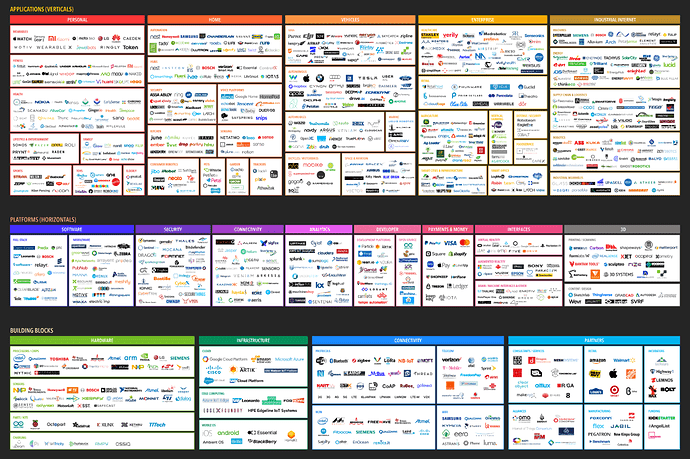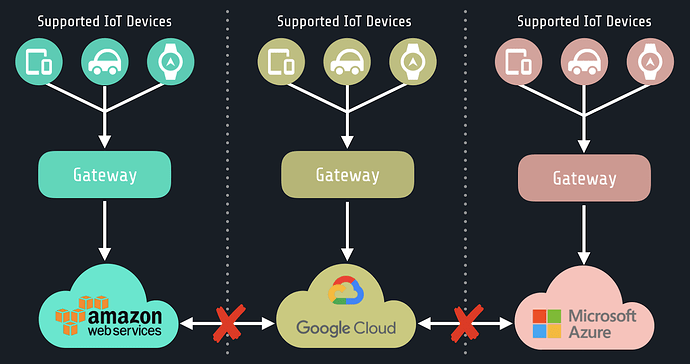The Internet of Things (IoT) is changing the way we live and work. Today, IoT lets us capture data and interact with connected devices to enhance our business processes and daily lives. Manufacturing, supply chain, smart cities, vehicles, wearables — IoT is effectively connecting the physical and digital world across many industries. It’s no wonder why McKinsey estimates IoT’s global market impact to be $3.9 — $11.1 trillion by 2025 As shown in the figure below, this massive market opportunity has attracted 400+ IoT platforms/solution providers (and counting), each vying to establish themselves as key players in this growing industry. So what is blockchain’s role in today’s IoT landscape?
IoT Platform Landscape ( Source: FirstMark Capital )
In our last blog “Blockchain & IoT: What’s it all about?” , we introduced the near-term opportunities for blockchain & IoT, which are centered around trusted data. In this blog, we take a deep dive into the current IoT landscape and highlight some bottlenecks that are hindering growth and adoption. We then explain why blockchain will ultimately activate IoT’s full potential by enabling interoperability across IoT devices, companies, and industries.
The Current IoT Landscape
A quick Google search of “IoT platforms” brings up a list of the world’s largest tech companies — Amazon, Google, Microsoft, Cisco, Salesforce, and more. These giants, whose IoT offerings are generally industry-agnostic, only represent a fraction of the IoT landscape. There are also hundreds of other offerings specializing in IoT solutions for specific industries (e.g., industrial IoT) or with specific capabilities across the IoT value chain, as shown below.
End-to-end IoT Value Chain
The 400+ IoT platforms / solution providers cater to various parts of the end-to-end value chain, but generally fall into one of these buckets:
- End-to-end IoT Platforms: fully managed IoT deployments including standard hardware, configurable software, connectivity services, and device management (e.g., OTA upgrades); Example: Particle
- Connectivity Management: managed solutions which offer tools (e.g., SIM cards) and services to connect companies to their IoT devices via WiFi, cellular, NB-IoT, and more; Example: Sigfox , Hologram
- IoT Cloud & Storage: Infrastructure-as-a-Service (IaaS) providing IoT-compatible tech stacks and backend services (e.g., ETL) which sync to connected devices and data; Example: AWS , Azure , Salesforce
- Data Routing & Analytics: tools managing data routing from IoT devices >> gateways >> databases >> third-party services, as well as analytics to extract insights from IoT data; Example: Clearblade , ThingSpeak
Why are Tech Giants Really in the IoT Sector?
Over the past months, we researched hundreds of IoT platforms/offerings and concluded that today’s IoT landscape is not only crowded, but also quite redundant from a capabilities perspective. This is especially true of IoT platforms from various tech giants, which offer similar IoT-related capabilities and compete based on price, user experience, and white-glove service. How did we reach this state of saturation and stagnant innovation? Why do so many tech giants offer IoT platforms, while traditional Cloud computing has consolidated to three players (AWS, Google, Microsoft)? Why does Salesforce, the world’s largest customer relationship management (CRM) company, even offer an IoT platform?
The answer is data ownership. Platforms that capture a critical mass of IoT data/devices in the near-term will be well-positioned to dominate the IoT market. Moreover, they will be difficult to dethrone due to vendor lock-in strategies:
- Data lock-in: Cloud operators make it easy to put data on the Cloud, but difficult and expensive to migrate data off
- Device lock-in: many IoT platforms require the use of specific IoT devices with closed APIs that are only compatible with their respective platforms
- Process lock-in: running production processes on top of data and devices further locks in users of the IoT platforms
Due to heavy competition, IoT platforms have no incentive to share data/market share with their competitors. In addition, no secure mechanism exists to seamlessly share data in real-time across IoT / Cloud platforms. The lack of urgency and means to address interoperability is a massive bottleneck on innovation within the IoT space and will continue to fragment the IoT landscape into monolithic data silos. Without a new approach that can enable data/device sharing and interoperability, we will never see the full potential of IoT.
Lack of real-time interoperability across traditional IoT platforms
IoT’s Next Frontier: Blockchain-enabled Interoperability
To recap an important statistic, the global market impact of IoT is estimated to be $3.9 — $11.1 trillion by 2025. You may be wondering why there is a $7.2 trillion difference between the low/high estimates. Of the total $11.1 trillion in potential market value, McKinsey estimates that 40–60% or $4.4 — $6.6 trillion will only be realized if true interoperability is achieved between IoT devices, companies, and industries. In other words, interoperability will more than double the global market value of IoT in the long-term. This is where blockchain will shine — by introducing new business opportunities based on interoperable networks.
As a highly secure distributed system with interoperability capabilities, blockchain is the perfect candidate to drive innovation in the IoT industry. Blockchain platforms with smart contracts and support of IoT devices can perform the same functions as traditional IoT platforms, while also enabling interoperability between IoT devices/companies. For example, IoTeX’s root chain/subchain architecture (shown below) enables transfers of data and value between heterogeneous IoT devices and applications via cross-chain communication.
IoTeX Architecture and Features
Blockchain’s Role in Today’s IoT Landscape
Although blockchain-based solutions must catch up to the scalability and user experience offered by traditional IoT platforms, they offer a promising approach to tackle the interoperability issue that hinders traditional solutions. Even permissioned (private) blockchains, which utilize public key infrastructures to control access management, are unable to successfully tackle the interoperability issue. True interoperability in the IoT sector is required to drive large-scale autonomous organizations and machine-to-machine interaction, and can only be enabled by public blockchains.
In the near-term, blockchain will complement existing IoT solutions by providing trusted data to inform decision-making and optimize processes. In the medium-term, new IoT applications leveraging blockchain-specific features will emerge and challenge traditional offerings. In the long-term, blockchain will unlock trillions of dollars in market value and enable true interoperability across heterogeneous IoT devices, companies, and industries.




